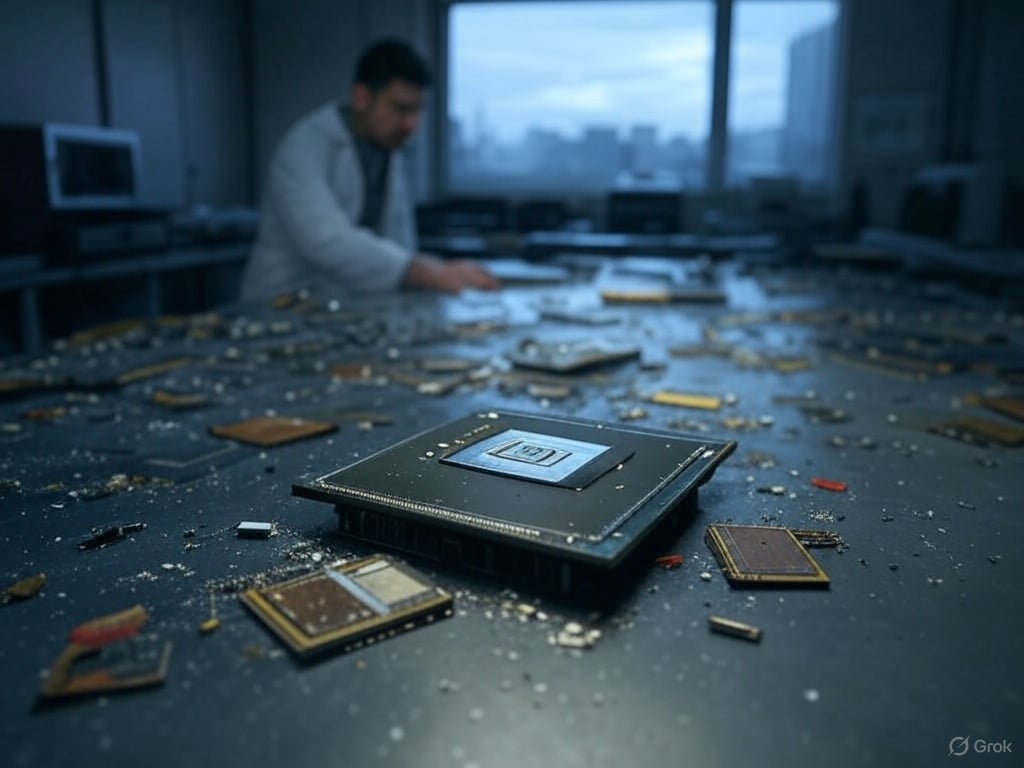The United States has stepped up its technological offensive against China with a measure that had previously flown under the media radar: the covert installation of location devices in select shipments of advanced chips produced by companies like Nvidia, AMD, and Dell, among others. According to an investigation by Reuters, these trackers are discreetly placed in packaging or even inside the servers themselves, aiming to detect and prevent their illegal diversion to destinations listed on export control lists.
This operation is characterized by an intelligence and trade control seal. Sources with direct knowledge of the operation explained that this practice is not applied to all shipments, but only to those already under investigation. In some cases, the devices, which can be as small as a smartphone, allow U.S. authorities to track the chips to their final destination.
The deployment of this technology involves multiple agencies, including the Bureau of Industry and Security (BIS) of the Department of Commerce, the Homeland Security Investigations (HSI) unit, and the FBI. The information gathered through these trackers is used to detect violations of export restrictions and to build legal cases against individuals or companies that breach them.
This type of technology is not new to the U.S. arsenal; similar tracking devices have been used to monitor sensitive exports such as aircraft parts. In recent years, the tactic has expanded to the semiconductor sector due to its strategic importance.
The context: a relentless tech war. The decision to monitor these shipments is part of a broader policy to control the transfer of advanced technology to China—a strategy intensifying since 2022. Washington seeks to prevent Beijing from accessing high-performance semiconductors that could enhance its military capabilities or AI industry.
Similarly, these restrictions also apply to countries like Russia, in a framework that covers both civilian and military uses of cutting-edge chips. The White House and Congress have even debated proposals requiring chips to include verification systems for location tracking, making diversion attempts more difficult.
Reactions from manufacturers have been cautious. Super Micro stated it doesn’t disclose its security policies and declined to comment on tracking actions. Dell claimed it was unaware of any U.S. government initiative to place trackers in its shipments. However, industry sources suggest that manufacturers and distributors are increasingly aware that authorities are monitoring the destination of AI chips, and some supply chains are implementing internal protocols to avoid involvement in investigations for violations.
China has retaliated diplomatically and in the media, criticizing Washington’s restrictions as a deliberate attempt to stifle its technological growth. Last month, China’s cybersecurity regulator summoned Nvidia to discuss alleged vulnerabilities or “backdoors” in its chips—allegations the American company strongly denied. Additionally, unofficial reports indicate some Chinese resellers inspect servers before delivery to detect potential trackers. In a recent U.S. Department of Justice case, a co-defendant advised another to “carefully search” servers equipped with Nvidia chips for tracking devices.
For Washington, this tracking system is not only about national security but also serves as a deterrent against intermediaries engaging in illicit tech trade. Installing tracking devices helps identify diversion routes and gather solid evidence for legal actions and sanctions.
From an industry perspective, this policy presents additional challenges. Chip manufacturers operating in a global market with narrow margins could face increased logistics costs, delays, and tensions with clients in non-restricted markets who might see these measures as invasive.
The global semiconductor supply chain is complex and interconnected. The U.S. leads in designing and manufacturing these components, but their production and assembly involve suppliers from multiple countries. Introducing trackers adds a new layer of traceability that could, in theory, be applied to other sensitive sectors like aerospace, nuclear energy, or biotechnology.
Moreover, this surveillance reflects a new phase of the U.S.-China tech war, where physical control of components holds as much importance as legal restrictions. The ultimate goal is to prevent cutting-edge technology from being used in ways that challenge U.S. military and economic supremacy.
Experts in international trade warn that this strategy could expand, not only in the volume of controlled shipments but also in the types of tracking devices used. Miniaturization and the development of more advanced geolocation systems could allow trackers to be hidden in nearly undetectable areas for the receiver.
However, this also raises questions about corporate privacy and supply chain integrity. While the security rationale is legitimate, lack of transparency in implementation could create friction with business partners and spark debates over the legality of such methods outside U.S. territory.
Frequently Asked Questions:
Why does the U.S. track AI chips sent to other countries?
To prevent advanced components from illegally reaching nations under export restrictions, like China or Russia, and to prevent their use for military or strategic purposes contrary to U.S. interests.
Where are the trackers placed in shipments?
They can be concealed within packaging or integrated inside the servers containing the chips, depending on the investigation’s level and risk.
Does this affect all shipments from Nvidia, AMD, or Dell?
No. Only specific shipments already under investigation or surveillance are impacted, according to U.S. authorities.
How has China responded to these measures?
China has accused Washington of trying to curb its technological progress, denied the existence of “backdoors” in chips, and reportedly reviews shipments to detect possible trackers.
Source: Times of India

